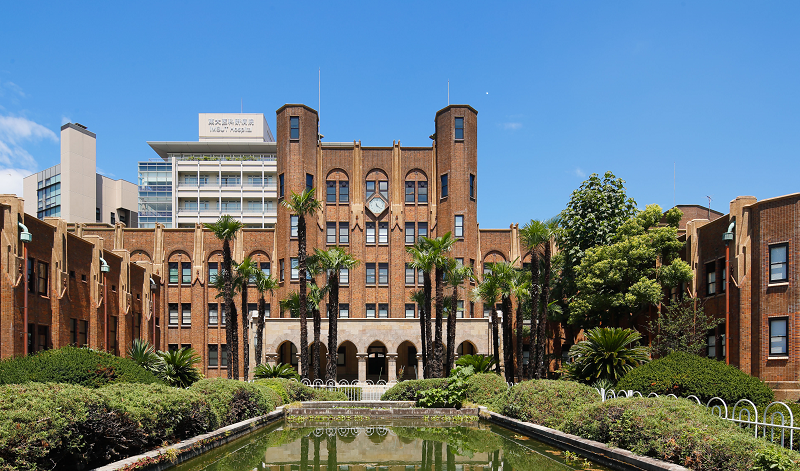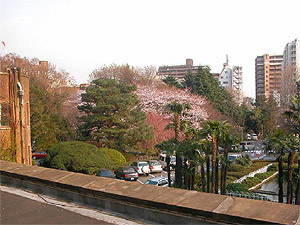Welcome to the Institute of Medical Science
Welcome to the Institute of Medical Science
2006-11-13
 The campus of the Institute of Medical Science, University of Tokyo (IMSUT) in Shirokane Heights is nestled between Meguro Street and Gaien-Nishi Street. Upon entering through the main gates facing Meguro Street, the greenery of the public grounds and the red-brown of the brick-constructed Medical Science Museum are first to catch one's eye. Continuing along the gently curving road, from between the trees the clock tower of the three-story gothic-style main building comes into view. In the immediate aftermath of the Great Kanto Earthquake of 1923, Yoshikazu Uchida, who would later become president of the University of Tokyo, designed the building according to research findings on earthquake and fire resistance. Towering just behind the main building are the brand new eight-story structures of the hospital building and the research building side-by-side. Viewed left to right, these buildings house basic research and clinical research in close juxtaposition. Come this far, and the greenery becomes sparse. On this site of approximately 70,000 square meters, approximately 1,000 faculty, researchers, postdocs, and graduate students in total are zealously pursuing medical and advanced clinical research.
The campus of the Institute of Medical Science, University of Tokyo (IMSUT) in Shirokane Heights is nestled between Meguro Street and Gaien-Nishi Street. Upon entering through the main gates facing Meguro Street, the greenery of the public grounds and the red-brown of the brick-constructed Medical Science Museum are first to catch one's eye. Continuing along the gently curving road, from between the trees the clock tower of the three-story gothic-style main building comes into view. In the immediate aftermath of the Great Kanto Earthquake of 1923, Yoshikazu Uchida, who would later become president of the University of Tokyo, designed the building according to research findings on earthquake and fire resistance. Towering just behind the main building are the brand new eight-story structures of the hospital building and the research building side-by-side. Viewed left to right, these buildings house basic research and clinical research in close juxtaposition. Come this far, and the greenery becomes sparse. On this site of approximately 70,000 square meters, approximately 1,000 faculty, researchers, postdocs, and graduate students in total are zealously pursuing medical and advanced clinical research.
A major feature of IMSUT is that it is the largest life sciences research institute in Japan to possess its own hospital. Even when Shibasaburo Kitasato established the private Institute for Infectious Disease, our institute's predecessor, over 100 years ago, from the very beginning the institute has possessed its own hospital, and based upon a "bench to bedside" consciousness, has advanced research and medical treatments with the care of suffering people in mind. About 40 years ago, as public health conditions had greatly improved, the institute began to carry out research not only into infectious diseases, but also into cancer and immune diseases. Currently, we are advancing cutting edge research into cancer, infectious diseases and other intractable illnesses. In recent years the stage has been set with the confluence of molecular and cell biology, remarkable engineering breakthroughs and the rapid development of genomics, so that now, building on genomic and proteomic bioinformatics, we are making strides toward grasping the complex dynamics of living organisms as systems. We proclaim it as the mission of our institute to advance such basic medical research, promote the translation of those finding to the clinic, and--based upon bioinformatics--put into practice "order-made" medical therapy tailored to the individual.
A diversity of thinking exists as to what a university should be doing. There are so many kinds of universities that they cannot all be placed in the same category, and each fullfills an important role. A unifying principle among all this diversity is that the baton of learning is handed off to the next generation of youth to carry on the future. As Japan's top center of academic research and education, the University of Tokyo explicitly states in its action plan that its goal is to build a summit of the world's learning. In other words, it is our mission to create a culture of scholarship for handed-down and newly acquired knowledge, mankind's crown jewels, and at the same time recognize our obligation and strive to share this knowledge with society at large. Within this larger framework, it is the role of the Institute of Medical Science to construct new bodies of knowledge from the huge amounts of information generated from findings in such fields as molecular biology, genome sciences and clinical medicine, and then use this life- and disease-related medical research to build a bridge to the future. With that goal in view, the Shirokane Heights Campus gathers together faculty, postdocs, and graduate students with backgrounds in such wide-ranging academic disciplines as medicine, pharmacy, physics, engineering, agriculture, mathematics and the humanities to propel medical research. This pursuit of research in the midst of such diversity will accelerate the creation of entirely new concepts. Of this I am confident.
 It scarcely needs mentioning that each scientist at IMSUT is contributing to the expansion of international research. At the institutional level, we are deepening ties with the Pasteur Institute, the University of California, Seoul National University, etc. Moreover, we have been exercising leadership over the past few years in Asia foremost in the area of infectious diseases, for example by establishing a joint laboratory with the Chinese Academy of Sciences. In addition we are deepening exchange with such institutions as China’s Tinghua University and Vietnam's Hanoi Medical University. IMSUT is firmly determined to continue as a center of world-class research to advance the cutting-edge of medical/life sciences.
It scarcely needs mentioning that each scientist at IMSUT is contributing to the expansion of international research. At the institutional level, we are deepening ties with the Pasteur Institute, the University of California, Seoul National University, etc. Moreover, we have been exercising leadership over the past few years in Asia foremost in the area of infectious diseases, for example by establishing a joint laboratory with the Chinese Academy of Sciences. In addition we are deepening exchange with such institutions as China’s Tinghua University and Vietnam's Hanoi Medical University. IMSUT is firmly determined to continue as a center of world-class research to advance the cutting-edge of medical/life sciences.
